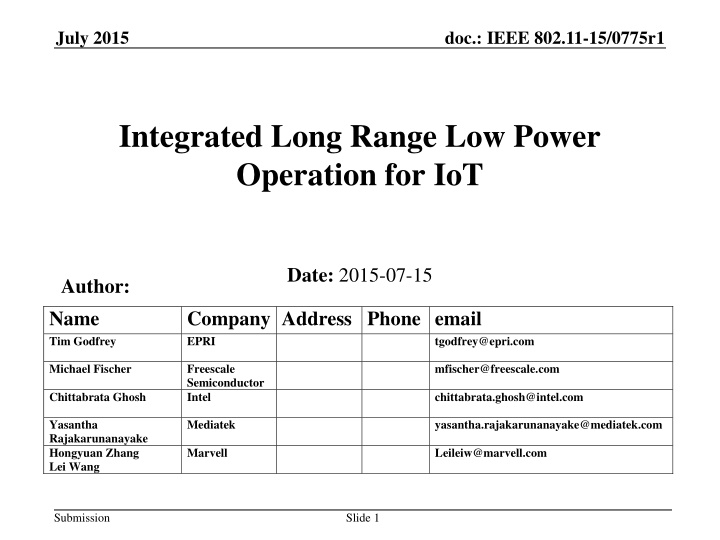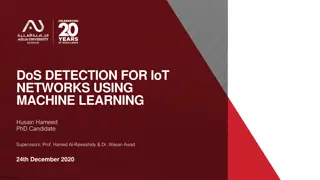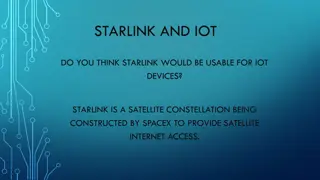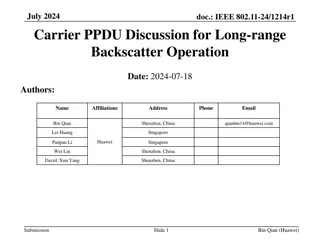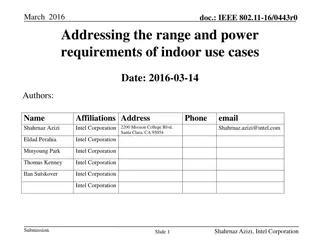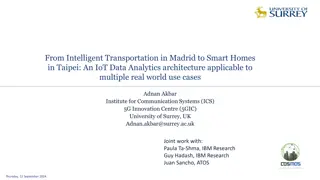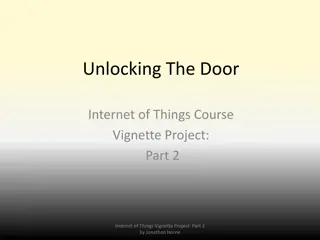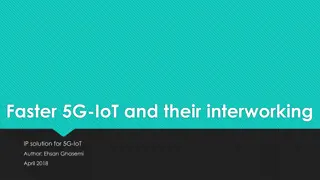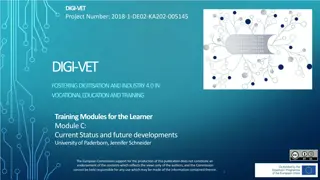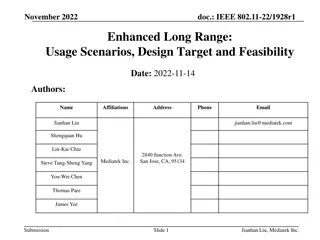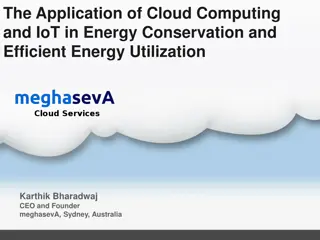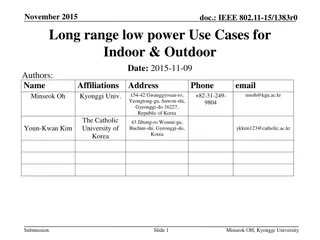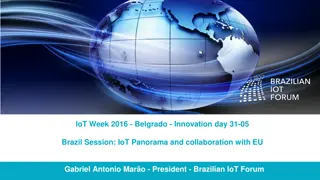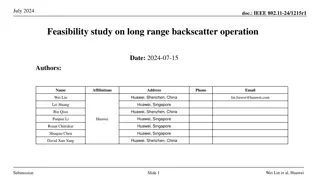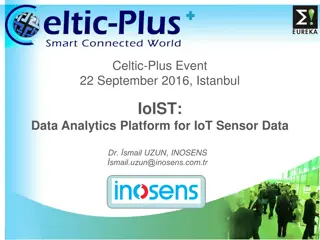Integrated Long Range Low Power Operation for IoT
Developing new MCS or PHY for long range, low power operation integrated into mainstream devices without additional hardware. Objective: 10 dB range improvement, 500m nominal range, 50uW average power consumption for battery life of over 5 years. Use cases focus on M2M and IoT applications with specific requirements for communication intervals, device power sources, and application scenarios.
Download Presentation

Please find below an Image/Link to download the presentation.
The content on the website is provided AS IS for your information and personal use only. It may not be sold, licensed, or shared on other websites without obtaining consent from the author.If you encounter any issues during the download, it is possible that the publisher has removed the file from their server.
You are allowed to download the files provided on this website for personal or commercial use, subject to the condition that they are used lawfully. All files are the property of their respective owners.
The content on the website is provided AS IS for your information and personal use only. It may not be sold, licensed, or shared on other websites without obtaining consent from the author.
E N D
Presentation Transcript
July 2015 doc.: IEEE 802.11-15/0775r1 Integrated Long Range Low Power Operation for IoT Date: 2015-07-15 Author: Name Tim Godfrey Company Address Phone email EPRI tgodfrey@epri.com Michael Fischer Freescale Semiconductor Intel mfischer@freescale.com Chittabrata Ghosh chittabrata.ghosh@intel.com Yasantha Rajakarunanayake Hongyuan Zhang Lei Wang Mediatek yasantha.rajakarunanayake@mediatek.com Marvell Leileiw@marvell.com Submission Slide 1
July 2015 doc.: IEEE 802.11-15/0775r1 Integrated Longer Range and Lower Power Develop new MCS or PHY for long range low power (LRLP) Integrated in air interface: Able to operate concurrently with existing network without adverse effect on existing devices Integrated into mainstream devices: Does not require additional hardware and components for implementation. Assumes new silicon (aligned with 802.11ax introduction) More than a firmware upgrade for existing products Range improvement objective 10 dB, 20dB stretch goal Nominal range of 500m Provide similar level of lower power requirements Average power consumption: 50uW Battery life longer than 5 years Submission Slide 2 Tim Godfrey, EPRI
July 2015 doc.: IEEE 802.11-15/0775r1 Results from May WNG Discussion Straw Poll: Would you support the formation of a Study Group to develop a PAR for Long Range mode intended for broad-market 802.11 products? Y: 15 N: 0 Needs more discussion: 35 No opinion: 2 Requests Articulate the use cases Detailed set of requirements. Submission Slide 3 Tim Godfrey, EPRI
July 2015 doc.: IEEE 802.11-15/0775r1 Description of Use Cases Applications focused on M2M and IoT Not bulk data transfer UL data of 5-32bytes Communication interval ranging from 500ms to 10 minutes Delay less than communication interval Devices may be AC line connected, or battery powered Scheduled or Coordinated medium access compliant IoT, Energy management, sensors Fixed location Out of way location (hot water heater, pool pump) Poor propagation e.g. side of White Goods appliance Indoor and outdoor applications Premises or property scale not a neighborhood area network Eliminate need for range extenders Possibly usable by general WLAN user (with manual enablement) When slow connection is better than no connection in very marginal connection conditions Submission Slide 4 Tim Godfrey, EPRI
July 2015 doc.: IEEE 802.11-15/0775r1 Thrust Areas of IoT 1.Smart buildings 2.Energy and Utility 3.Consumer and connected home 4.Healthcare 5.Industrial Automation 6.Transportation 7.Security/Public Safety 8.IT Networks 9.Retail Submission Slide 5 Tim Godfrey, EPRI, et al
July 2015 doc.: IEEE 802.11-15/0775r1 Requirements Zero marginal cost for implementation Available in all next-generation 802.11 chipsets Possible to define LRLP only STA Implemented a lower cost: similar to S1G sensor STA AP is based on standard silicon 10 dB link margin improvement Low energy consumption (average consumption of 50uW) for battery operated devices Relatively low aggregate data rate ~ 512Kbps Actual PHY data rate may be higher Coexistence and limited impact on primary BSS Protection mechanisms, media occupancy limit, duty cycle limit, etc. Submission Slide 6 Tim Godfrey, EPRI
July 2015 doc.: IEEE 802.11-15/0775r1 Why is LRLP needed when we have 802.11ah? Although targeting 2.4 GHz, LRLP should be band-agnostic Long range functionality supported by 11ah needs to be extended to higher bands This capability is intended for entry-level implementations Would operate on existing network, on mass market APs and routers Energy and M2M desire to leverage existing customer broadband using 802.11 Objective: LRLP would eventually become available on all mainstream consumer and enterprise WLAN devices Ideally every AP would support this capability in "next generation" silicon Submission Slide 7 Tim Godfrey, EPRI
July 2015 doc.: IEEE 802.11-15/0775r1 Why not 802.11b? Goal of > 10dB range improvement exceeds what is achievable with 802.11b at 1 Mbps 802.11b doesn t take advantage of newer techniques like MIMO and beamforming Can MIMO be leveraged for range instead of rate? Beam Forming Transmission advantages for LRLP 802.11b waveform and bandwidth puts a floor on achievable energy reduction 802.11b protection mechanisms have an adverse affect on BSS throughput Can we use newer MAC techniques for lower impact (and more control) on overall BSS throughput? Submission Slide 8 Tim Godfrey, EPRI
July 2015 doc.: IEEE 802.11-15/0775r1 Pathloss, Regulatory Limits and Spectrum considerations of 900MHz and 2.4GHz Region 11ah/900MHz Power 2.4GHz Power China 5mW 100mW USA 1000mW 1000mW South Korea (917-923MHz) 10mW 100mW Europe (863-869MHz) 25mW 100mW Singapore (920-925MHz) 500mW 200mW Japan (920.5-923.5MHz) 250mW 10mW/MHz Pathloss advantage ~(1/f^2); (2.4/.9)^2 = 7 = 8.4dB advantage for ideal antennas; The advantage comes from larger ideal antenna aperture; hard to realize full benefit because of antenna size; 2.4 Antennas are always smaller Most countries except Singapore and Japan, 2.4 Power is larger Some countries both powers are larger than needed for IOT (100mW) Many countries 900MHz allowed spectrum smaller (few MHz) compared to 85MHz or more of 2.4GHz availability Submission Slide 9 Tim Godfrey, EPRI
July 2015 doc.: IEEE 802.11-15/0775r1 Long Range / Low Power Optimization LRLP operation can be parameterized to optimize for range or power, depending on use case and link Provides benefits even at limits: e.g. even at the low power end, the range is better than legacy, and the power is lower than legacy at the higher power end. Longer Range Shorter Range Higher Power Lower Power Submission Slide 10 Tim Godfrey, EPRI
July 2015 doc.: IEEE 802.11-15/0775r1 Consider benefits of narrower channel A potential approach: A reduced channel width for LRLP may be effective to accomplish both goals of long range and lower power. 2 MHz is a basic channel width for 802.11ah 2 MHz is proposed as 802.11ax UL-OFDMA allocation block [1] APs and Full-function STAs support both 2 MHz and 20 MHz LRLP-only STA may be designed with a total receiver BW of 2 MHz Power consumption benefits come from the ELIMINATION of the requirement to receive in a 20MHz (or wider) channel far more than from the ABILITY to receive in a 2MHz channel. Adding a 2MHz mode to an OFDM PHY would not meet this objective. [1] 15/0354r1 Bandwidth granularity on UL-OFDMA data allocation . Submission Slide 11 Tim Godfrey, EPRI, et al
July 2015 doc.: IEEE 802.11-15/0775r1 Potential Integration Approach Define PHY operation that provides both long range and low power Devices don t have to take advantage of long range They choose the best TX power, modulation and coding based on link conditions. Use link adaptation. Able to leverage MU-MIMO with 10 simultaneous LRLP users in 20 MHz channel for lowest power Compatibility with the smallest OFDMA channel proposed in 802.11ax Wideband operation for longest range If range is limited by multipath, 20 MHz gives better performance If range is limited by attenuation, narrow channel can be better If range is limited by frequency selective fading, wider channel is better If range is limited by adjacent channel, narrow is better If range is interference limited, narrow is better Easier to increase TX power in narrow channel Narrow channel at legal limit is more cost effective and power efficient Submission Slide 12 Tim Godfrey, EPRI
July 2015 doc.: IEEE 802.11-15/0775r1 Potential Low Power Approach 2 MHz Bandwidth at the STA Support standardized operation of next generation billion IoT devices Includes remote sensors with coin cell batteries Design of a narrowband, specifically 2MHz transceiver will provide reduced power consumption when compared to 20MHz transceiver 25%-52% reduction in RF domain during RX depending on MCS 4 times reduction in digital domain during RX Not significant gain in terms of power consumption in TX Submission Slide 13 Tim Godfrey, EPRI
July 2015 doc.: IEEE 802.11-15/0775r1 Potential Protection Approach Beacons transmitted in 20MHz for legacy compatibility LRLP devices unable to decode legacy Beacon (due to range or BW) Restructure LRLP beacons shorter, maybe less frequent Only include elements relevant to LRLP PHY. Minimum of information on BSS and basic capability. Everything else the station requires may be obtained using the Request Element in Probe frames. The LRLP should have a DTIM in every one of its beacons, with an appropriately longer LRLP beacon interval. The Listen Interval, or something like it, would be available for stations that do not want to wake up for every LRLP beacon Trigger frames in 802.11ax planned to be sent in 20MHz 11ax uses trigger frames for MU UL frames Specialized trigger frames for UL from LRLP devices AP supervises heterogeneous network of conventional and LRLP (IoT) STAs Submission Slide 14 Tim Godfrey, EPRI
July 2015 doc.: IEEE 802.11-15/0775r1 Limitation of Impact on Network Specify Medium Occupancy Limit for LRLP operation Comparable to full rate packets Additionally, specify a maximum average time on air (duty cycle). Intended applications are focused on M2M and IoT Not for bulk data transfer Low offered load is assumed Doesn t require a low data rate could be high rate low duty cycle Use best available rate for link and power constraints Submission Slide 15 Tim Godfrey, EPRI
July 2015 doc.: IEEE 802.11-15/0775r1 Summary Longer Range operation In mainstream 802.11 Lower Power operation Enable battery powered IoT Integrated with mainstream networks Interoperable in mixed BSS case Integrated with mainstream products Negligible incremental cost for implementation at an AP Acceptable to have a specialized low-cost silicon for LRLP STA, but the AP should be based on standard silicon. Intended for M2M managed impact on existing network. Medium Occupancy Limit, average occupancy limit Other mechanisms as appropriate Submission Slide 16 Tim Godfrey, EPRI
July 2015 doc.: IEEE 802.11-15/0775r1 Distinct Identity When defining a PAR, is there a concern with Distinct Identity and overlap with scope of 802.15? LRLP is built around entry level 802.11 infrastructure and does not require hardware for a new band or a new radio. No, because a basic requirement is the ability to integrate with existing WLAN infrastructure The LRLP flavor of 802.11 is manageable using the existing (enterprise-oriented and carrier-oriented) 802.11 network management facilities, AND can leverage the enormous deployed internet access infrastructure available from residential/soho/hotspot/public 802.11 networks. Neither of these are true of 802.15 networks. Submission Slide 17 Tim Godfrey, EPRI
July 2015 doc.: IEEE 802.11-15/0775r1 Straw Poll Straw Poll: Would you support the formation of a Study Group to develop a PAR for Long Range Low Power operation, intended for broad- market 802.11 products? Submission Slide 18 Tim Godfrey, EPRI, et al
